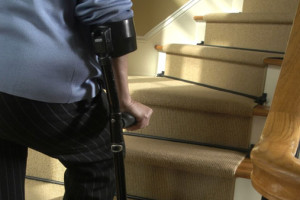A Disability Lawyer's Perspective At the head of Social Security Administration is the Commissioner of…
Can I get disability if I need a walker or wheelchair? Disability Attorneys
 Disability if I need a walker or wheelchair?
Disability if I need a walker or wheelchair?
As discussed elsewhere on this website, the Social Security Administration undertakes a five-step evaluation to determine whether someone is disabled under the Social Security Act. If an individual is not working too much and has a significant medical impairment they will be considered disabled at Step 3 if they meet or equal one of the listed impairments. The Listing of Impairment can be found at: https://www.ssa.gov/disability/professionals/bluebook/AdultListings.htm.
A while ago, the Social Security Administration proposed a major change in some of the most popular listed impairments. See proposed changes in full at: https://www.federalregister.gov/documents/2018/05/07/2018-08889/revised-medical-criteria-for-evaluating-musculoskeletal-disorders.
This major change involves the musculoskeletal system. Two of the listings that disability lawyers have utilized the most to prove that their clients qualify for benefits involve the spine and major weight bearing joints (typically knees and hips). The current listing for major joint dysfunction is as follows:
1.02 Major dysfunction of a joint(s) (due to any cause): Characterized by gross anatomical deformity (e.g., subluxation, contracture, bony or fibrous ankylosis, instability) and chronic joint pain and stiffness with signs of limitation of motion or other abnormal motion of the affected joint(s), and findings on appropriate medically acceptable imaging of joint space narrowing, bony destruction, or ankylosis of the affected joint(s). With:
A. Involvement of one major peripheral weight-bearing joint (i.e., hip, knee, or
ankle), resulting in inability to ambulate effectively, as defined in 1.00B2b;
OR
B. Involvement of one major peripheral joint in each upper extremity (i.e., shoulder,
elbow, or wrist-hand), resulting in inability to perform fine and gross movements
effectively, as defined in 1.00B2c.
Section 1.00 B2b explains:
b. What we mean by inability to ambulate effectively.
(1) Definition. Inability to ambulate effectively means an extreme limitation of the
ability to walk; i.e., an impairment(s) that interferes very seriously with the
individual’s ability to independently initiate, sustain, or complete activities.
Ineffective ambulation is defined generally as having insufficient lower extremity
functioning (see 1.00J) to permit independent ambulation without the use of a hand-
held assistive device(s) that limits the functioning of both upper extremities.
(Listing 1.05C is an exception to this general definition because the individual has
the use of only one upper extremity due to amputation of a hand.)
(2) To ambulate effectively, individuals must be capable of sustaining a reasonable
walking pace over a sufficient distance to be able to carry out activities of daily
living. They must have the ability to travel without companion assistance to and from
a place of employment or school. Therefore, examples of ineffective ambulation
include, but are not limited to, the inability to walk without the use of a walker,
two crutches or two canes, the inability to walk a block at a reasonable pace on rough
or uneven surfaces, the inability to use standard public transportation, the inability
to carry out routine ambulatory activities, such as shopping and banking, and the
inability to climb a few steps at a reasonable pace with the use of a single hand
rail. The ability to walk independently about one’s home without the use of assistive
devices does not, in and of itself, constitute effective ambulation.
https://www.ssa.gov/disability/professionals/bluebook/1.00-Musculoskeletal-Adult.htm#1_02
The listing for spinal disorders (herniated discs, degenerative joint disease etc.) currently states:
1.04 Disorders of the spine (e.g., herniated nucleus pulposus, spinal arachnoiditis,
spinal stenosis, osteoarthritis, degenerative disc disease, facet arthritis, vertebral
fracture), resulting in compromise of a nerve root (including the cauda equina) or the
spinal cord. With:
A. Evidence of nerve root compression characterized by neuro-anatomic distribution of
pain, limitation of motion of the spine, motor loss (atrophy with associated muscle
weakness or muscle weakness) accompanied by sensory or reflex loss and, if there is
involvement of the lower back, positive straight-leg raising test (sitting and supine);
OR
B. Spinal arachnoiditis, confirmed by an operative note or pathology report of tissue
biopsy, or by appropriate medically acceptable imaging, manifested by severe burning or
painful dysesthesia, resulting in the need for changes in position or posture more than
once every 2 hours;
OR
C. Lumbar spinal stenosis resulting in pseudo claudication, established by findings on
appropriate medically acceptable imaging, manifested by chronic non radicular pain and
weakness, and resulting in inability to ambulate effectively, as defined in 1.00B2b.
https://www.ssa.gov/disability/professionals/bluebook/1.00-Musculoskeletal-Adult.htm#1_02
The proposed new listing for major joints (including weight bearing joints) states:
1.18 Abnormality of a major joint(s) in any extremity (see 1.00I), documented by A, B,
C, and D:
A. Chronic joint pain or stiffness.
AND
B. Abnormal motion, instability, or immobility of the affected joint(s).
AND
C. Anatomical abnormality of the affected joint(s) noted on:
1. Physical examination (for example, subluxation, contracture, bony or fibrous
ankylosis); or
2. Imaging (for example, joint space narrowing, bony destruction, or ankylosis or
arthrodesis of the affected joint).
AND
D. Impairment-related physical limitation of musculoskeletal functioning that has
lasted, or can be expected to last, for a continuous period of at least 12 months, and
medical documentation of at least one of the following (see 1.00E):
1. A documented medical need for a walker, bilateral canes, or bilateral crutches; or
2. An inability to use one upper extremity to independently initiate, sustain, and
complete work-related activities involving fine and gross movements, and a documented
medical need for a one-handed assistive device that requires the use of the other
upper extremity; or
3. An inability to use both upper extremities to the extent that neither can be used to
independently initiate, sustain, and complete work-related activities involving fine
and gross movements.
The proposed new spinal disorder listing will now be under Section 1.15. It is proposed to state:
1.15 Disorders of the skeletal spine resulting in compromise of a nerve root(s)(see
1.00F), documented by A, B, C, and D:
A. Symptom(s) of neuro-anatomic (radicular) distribution of one or more of the
following manifestations consistent with compromise of the affected nerve root(s):
1. Pain; or
2. Paresthesia; or
3. Muscle fatigue.
AND
B. Radicular neurological signs present during physical examination or testing and
evidenced by 1, 2, and 4; or 1, 3, and 4 below:
1. Muscle weakness; and
2. Sensory changes evidenced by:
a. Decreased sensation; or
b. Sensory nerve deficit (abnormal sensory nerve latency) on electrodiagnostic testing;
or
3. Decreased deep tendon reflexes; and
4. Sign(s) of nerve root irritation, tension, or compression, consistent with
compromise of the affected nerve root (see 1.00F2).
AND
C. Findings on imaging consistent with compromise of a nerve root(s) in the cervical
or lumbosacral spine (see 1.00C3).
AND
D. Impairment-related physical limitation of musculoskeletal functioning that has
lasted, or can be expected to last, for a continuous period of at least 12 months,
and medical documentation of at least one of the following (see 1.00E):
1. A documented medical need for a walker, bilateral canes, or bilateral crutches; or
2. An inability to use one upper extremity to independently initiate, sustain, and
complete work-related activities involving fine and gross movements, and a documented
medical need for a one-handed assistive device that requires the use of the other
upper extremity; or
3. An inability to use both upper extremities to the extent that neither can be used
to independently initiate, sustain, and complete work-related activities involving
fine and gross movements.
What does this mean for disability claimants?
It is probably going to be harder to get disability at Step 3 under the Listing of Impairments for most people with lower back and/or leg problems. Previously/currently, it is not necessary to need a walker, bilateral canes or bilateral crutches to be found disabled under listing 1.04A (nerve root/spinal cord compression of the spine). Additionally, it was not always necessary to need a walker, bilateral canes or bilateral crutches to be considered disabled under 1.02A (major weight bearing joints) as there was an inconsistency leaving room for argument between b(1) and b(2). See above.
Under the proposed ruling, if your upper extremities are not affected by any medical condition, the only way to be considered disabled for these conditions at Step 3 will be if there is medical documentation that you need ambulatory devices like a walker, bilateral canes or crutches. A single cane is not enough, problems walking a block is not enough, problems walking on uneven surfaces is not enough, and the objective findings alone which would have previously satisfied the lumbar spine listing is no longer enough.
Despite the foregoing, it is notable that at the hearing level, most individuals are not found disabled at Step 3 under the listing of impairments. Instead, most who win their disability claim are found disabled at Step 5 because their health prevents them from sustaining gainful and competitive employment. Therefore, you can still win your case for disability even if you do not meet the above criteria. Nonetheless, this proposed change will, no doubt, make it more difficult for many individuals (especially those under age 50, see previous blogs about the GRID Regulations) to be found entitled to disability benefits. On the bright side, one way that this proposed regulation benefits disability clients is when they have weight bearing joint problems, require a cane, and have an upper extremity restrictions from another condition (like carpal tunnel syndrome) in the hand that they do not carry their cane. This proposed regulation could make those in this scenario have a less disputable disability claim.
If you believe that your condition meets the above criteria, please contact us and we would be happy to discuss your options with you.





This Post Has 0 Comments